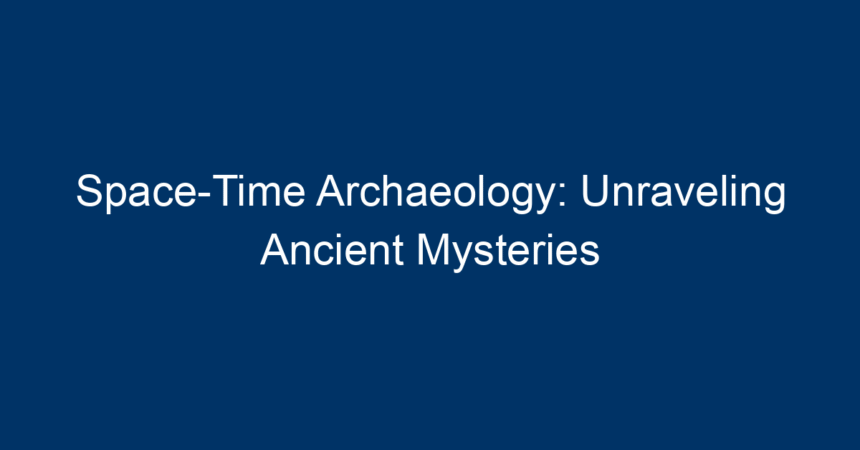Introduction
Imagine walking through time, not just tracing the steps of our ancestors but experiencing the very fabric of their lives. This is the promise of space-time archaeology—a revolutionary approach that merges archaeology with the principles of space-time physics. By integrating spatial analysis with time, researchers are beginning to unravel ancient mysteries in ways previously thought impossible. This article will take you on a journey through the fascinating world of space-time archaeology, exploring its methods, findings, and implications for our understanding of history.
What is Space-Time Archaeology?
Space-time archaeology is a multidisciplinary approach that combines traditional archaeological methods with modern scientific techniques, particularly from physics and geography. This field seeks to plot historical events in both spatial and temporal dimensions. By doing so, archaeologists can create a more nuanced understanding of past human behaviors, migrations, and interactions, allowing for a more comprehensive reconstruction of ancient societies.
The Principles of Space-Time
At its core, space-time is a framework that combines the three dimensions of space with the dimension of time into a single continuum. This idea was popularized by Albert Einstein’s theories of relativity and provides a unique perspective on how we view history. Instead of considering events in isolation, space-time archaeology focuses on how those events are interrelated over time and space.
Why Space-Time Matters in Archaeology
Understanding the context of ancient artifacts and structures involves more than simply dating them. When archaeologists investigate both the spatial layout and the chronological timeline, they can uncover patterns of movement, trade routes, and social structures. This depth of understanding is crucial for answering complex questions about human history.
The Methodologies of Space-Time Archaeology
GIS and Spatial Analysis
Geographic Information Systems (GIS) have become indispensable tools in space-time archaeology. These advanced mapping technologies allow researchers to visualize archaeological data geographically. By layering different types of information, such as artifact distribution, landscape features, and historical environmental changes, archaeologists can identify significant patterns that provide insights into ancient human activity.
Radiocarbon Dating and Chronological Mapping
Chronological mapping is another essential aspect of space-time archaeology. Techniques such as radiocarbon dating provide precise data on when artifacts and sites were created. By combining these dates with spatial data, researchers can develop timelines that reflect not just the sequence of events but also their geographic contexts.
Remote Sensing Technologies
Remote sensing technologies, including satellite imagery and aerial surveys, allow archaeologists to discover previously hidden sites. These technologies can reveal structures that are not visible from the ground, enabling researchers to create a more comprehensive picture of an area’s historical significance.
Case Studies in Space-Time Archaeology
The Nazca Lines, Peru
One of the most fascinating applications of space-time archaeology can be seen in the study of the Nazca Lines in Peru. These enormous geoglyphs, depicting various animals and shapes, are etched into the desert floor. By combining spatial analysis and chronological data, researchers have begun to piece together the societal and astronomical significance of these formations, suggesting they may have served as ritual pathways or celestial calendars.
The Indus Valley Civilization
In South Asia, space-time archaeology has shed light on the Indus Valley Civilization (IVC). Researchers have used GIS to analyze the layout of urban centers like Mohenjo-Daro and Harappa. By placing these cities in the context of their surrounding environment and trade routes, they have gained insights into the economic and social systems that governed this ancient civilization.
Ancient Trade Routes
Another compelling case is the study of ancient trade routes, particularly those of the Silk Road. By applying space-time archaeological methods, scholars can trace the movement of goods and ideas across vast distances, illustrating the complexity and interconnectedness of ancient societies. This research helps us understand how cultures influenced each other through trade and interaction.
The Challenges Faced in Space-Time Archaeology
Data Limitations
Despite its promise, space-time archaeology faces several challenges. One significant issue is the availability and quality of data. Archaeological sites often suffer from incomplete records or insufficient artifacts, making it difficult to paint a complete picture. As researchers push for more comprehensive data collection methods, collaboration among disciplines becomes vital.
Interdisciplinary Collaboration
The nature of space-time archaeology requires collaboration among various disciplines, including physics, computer science, and anthropology. While this interdisciplinary approach can yield rich insights, it may also lead to communication challenges between experts with different terminologies and methodologies.
Ethical Considerations
As with any archaeological endeavor, ethical considerations must be at the forefront. The integration of advanced technologies raises questions about cultural heritage, land use, and respect for indigenous communities. It is essential for researchers to approach their work with sensitivity and awareness of the historical implications.
The Future of Space-Time Archaeology
The future of space-time archaeology holds great promise for deepening our understanding of ancient cultures. As technology continues to evolve, the field is likely to witness advancements in data collection, analysis methods, and interpretative frameworks. Increased collaboration among scientists, archaeologists, and technologists can lead to groundbreaking discoveries.
Expanding Research Frontiers
Emerging technologies, like artificial intelligence and machine learning, are poised to revolutionize how archaeologists analyze data. These tools can help in predicting artifact placements based on spatial data, making it easier to uncover new sites and patterns that were previously overlooked.
Public Engagement and Education
Increased public interest in archaeology also stands to benefit from the advancements made in space-time archaeology. Interactive platforms that leverage GIS and other visualization tools can facilitate a deeper understanding of ancient societies, allowing the public to engage with history in innovative ways.
Conclusion
Space-time archaeology stands at the forefront of a fascinating intersection between science and the humanities. Its ability to unravel the complexities of ancient societies through spatial and temporal analysis opens the door to a wealth of knowledge about our past. As we continue to explore this field, we must remain committed to ethical practices and foster interdisciplinary collaborations that enrich our understanding of human history.
So, whether you’re an aspiring archaeologist, a history enthusiast, or simply curious about our collective past, embracing the principles of space-time archaeology can provide you with new insights into the intricate tapestry of human civilization. Start exploring—each layer of history is waiting to be uncovered!




